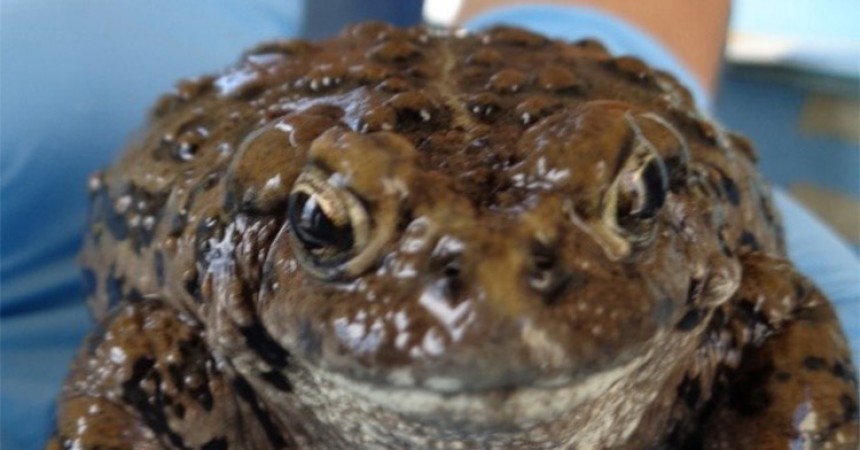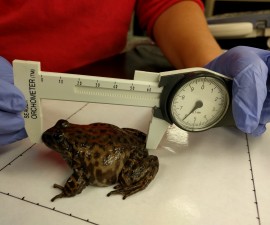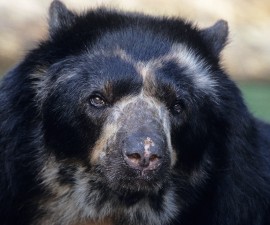From the window of a fancy trailer, I can see the small town of Alamosa, Colorado, and lying just behind it, the base of the Rocky Mountains. A gateway to all the many outdoor splendors that the Colorado wilderness has to offer, this small town bustles with the comings and goings of natives, as well as passers-through. However, Alamosa hides another interesting little secret. The Native Aquatic Species Restoration Facility, known as NASRF, is part of the Colorado Division of Parks and Wildlife dedicated to the restoration of 10 species of fish native to Colorado. Additionally (and perhaps more importantly for me), NASRF holds one of the largest collections of a single toad species in the US.
The southern Rocky Mountain population (SRMP) of boreal toad (Anaxyrus boreas boreas) is a geographically isolated population of the boreal toad (Anaxyrus boreas). Although the boreal toad is commonly found in the western part of the US, the SRMP is unique due to its limited geographical distribution, which restricts it to high elevations of montane wetland in Colorado, New Mexico, Utah and southeastern Wyoming. As part of a comprehensive plan to restore and manage the SRMP, a specialized group known as the Boreal Toad Recovery Team (BTRT) was established in 1995, and a captive population has been housed at NASRF since 2001. Over 600 individual toads from different localities in the wild are held and bred as a genetic assurance colony, from which tadpoles are re-introduced annually.
Amphibians are a curious group of animals. The diversity of physiological adaptations and environmental requirements makes breeding them in captivity difficult. Such is the case with the Boreal toads at NASRF.
One of the most interesting adaptations of the boreal toad is its ability to hibernate. Because they are found at high altitudes and latitudes, they have evolved this behavior to cope with long, harsh winters. However, hibernation in amphibians is not exactly the same as in mammals. In fact, the proper term for this behavior in amphibians is brumation. Like hibernating mammals, temperate amphibians lower their metabolic rates in response to falling temperatures in fall and winter. They stop eating and reduce their activity, but unlike mammals, they do not become dormant. At the beginning of spring, as temperatures rise, boreal toads come out of hibernation and immediately begin to breed.
Although temperature appears to be a key factor influencing reproduction in the Boreal toad, we are not sure how other important factors such as light and nutrition affect adult health and reproduction. At NASRF, we provide special UV lighting to emulate natural day and night cycles, a diverse diet, controlled water temperature, and artificial hibernation during the winter months. In short, we do what we can to replicate the outdoors, indoors.
In May of 2014, I made the long 1,000-mile drive from San Diego to Alamosa to join the staff at NASRF, in preparation for boreal toad breeding season. That’s not me in the photograph, that’s my trusty partner, Sancho. Seventeen hours later, we arrived at our new and very swanky home, where we would reside for the next 4.5 months. Now I guess I should explain why I told you all about the boreal toad in the beginning, and more importantly, where I fit into the picture. As I mentioned, during the winter months, boreal toads hibernate in the wild. To emulate this at NASRF we use giant refrigerators (the kind you find in restaurants). We box the little toads up with soft, moist sand and peat moss, and put them to bed for five to six months. Odd as this may seem, this period of cold is exactly what these toads need to get them in the mood for love and romance. Emerging from hibernation is like traveling to a sunny beach destination with your partner for a romantic holiday after surviving a long winter.
So, where do I come in? I am a reproductive physiologist working for the San Diego Zoo’s Institute for Conservation Research. About four years ago, I moved to the US to work on amphibians as a post-doctoral fellow at the University of Mississippi. During my post-doc, I concentrated on the application of assisted reproductive technologies to promote reproduction in captive amphibians. When natural matings occur in boreal toads we expect to see certain reproductive behaviors, such as males amplexing females. This clasping behavior may persist for days while the male stimulates the female to deposit her eggs. When breeding does not occur or a female fails to release eggs naturally, I inject females with hormone treatments designed to elicit egg deposition. I also use the same hormones to induce sperm production in males.
Like in humans, ultrasound helps us monitor female toad reproductive cycles by visualizing the ovary and determining the presence and size of eggs. This helps us know if a female that has not bred is ready to deposit eggs. If so, I would inject her with hormones. Once eggs have been deposited, we count the number of eggs that have been fertilized and are cleaving (dividing). Embryonic development is recorded by looking at embryos every day and cataloging different developmental stages.
We raise tadpoles in captivity until they reach a certain size and have developed back legs, before transporting them to the Rocky Mountain National Park for release into the wild. This final stage of the adventure is managed and monitored by the dedicated staff at NASRF and the National Park. Saving the SRMP boreal toad is a collaborative project, with the ultimate goal of restoring these animals in their natural habitat.
(I’d like to thank all the staff at the Native Aquatic Species Restoration Facility for their help).
Natalie Calatayud is a research associate at the San Diego Zoo Institute for Conservation Research.








